TotalEnergies Bundle
Who Really Owns TotalEnergies?
In an era of fluctuating energy markets and evolving sustainability goals, understanding the TotalEnergies SWOT Analysis is more critical than ever. TotalEnergies, a global energy leader, has undergone a significant transformation. Knowing who controls this powerhouse is key to grasping its future trajectory and its impact on the global energy landscape.
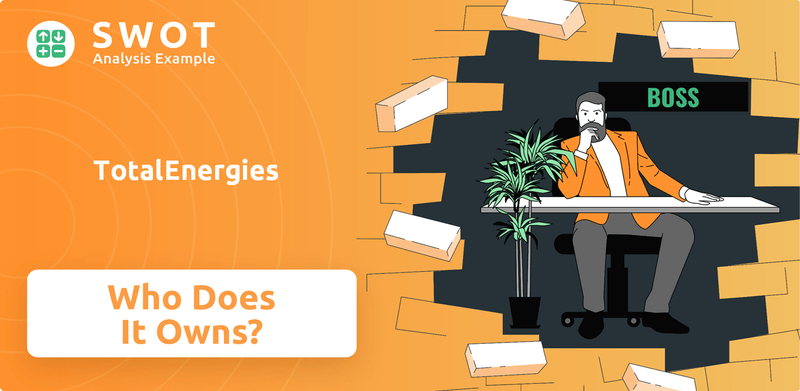
The question of "Who owns TotalEnergies?" is paramount for investors, analysts, and anyone interested in the energy sector. This exploration into TotalEnergies ownership will uncover its history, from its founding as Compagnie Française des Pétroles (CFP) to its current status as a diversified energy giant. We'll examine the influence of TotalEnergies shareholders and the implications of its strategic shift towards renewable energy sources.
Who Founded TotalEnergies?
The story of TotalEnergies, and who owns TotalEnergies, begins on March 28, 1924, with the establishment of the Compagnie Française des Pétroles (CFP) in France. This marked the genesis of what would become a global energy giant. The company's formation was driven by the French government's desire for energy independence.
Ernest Mercier, a graduate of the French Polytechnique engineering school, was appointed as the first chairman of CFP. The initial mission was clear: to develop oil exploration and production capabilities. This strategic move was aimed at securing France's energy resources, a critical aspect of national policy.
In its early years, CFP secured a 25% stake in the Turkish Petroleum Company, a move that integrated it into the existing European oil industry landscape. The company's journey from a state-backed entity to a publicly traded corporation reflects its evolution and expansion.
CFP was founded in 1924 on the initiative of the French government, with Ernest Mercier as the first chairman. The primary goal was to ensure France's energy independence through oil exploration and production.
CFP acquired a 25% share in the Turkish Petroleum Company, integrating it into the European oil market. This strategic move helped the company expand its reach and influence in the industry.
In 1929, CFP shares were listed on the Paris stock exchange, opening up investment opportunities. In 1945, the French government nationalized CFP, reinforcing its role in national energy security.
The core vision of CFP from its inception was to ensure France's energy independence. This focus shaped its early strategies and investments.
Specific equity splits and early agreements are not detailed in readily available public information due to the company's initial state-owned status. The focus was on national energy security.
The company's ownership structure has evolved significantly since its founding, transitioning from state control to a publicly traded entity. This shift reflects broader changes in the energy sector.
The evolution of TotalEnergies' ownership structure, from its inception as a state-owned entity to its current status as a publicly traded company, is a testament to its adaptability and growth. Understanding the TotalEnergies ownership structure provides insights into its strategic decisions and market position. To learn more about the company's strategic direction, consider reading about the Growth Strategy of TotalEnergies. This historical context is crucial for understanding the company's current operations and future prospects.
TotalEnergies SWOT Analysis
- Complete SWOT Breakdown
- Fully Customizable
- Editable in Excel & Word
- Professional Formatting
- Investor-Ready Format
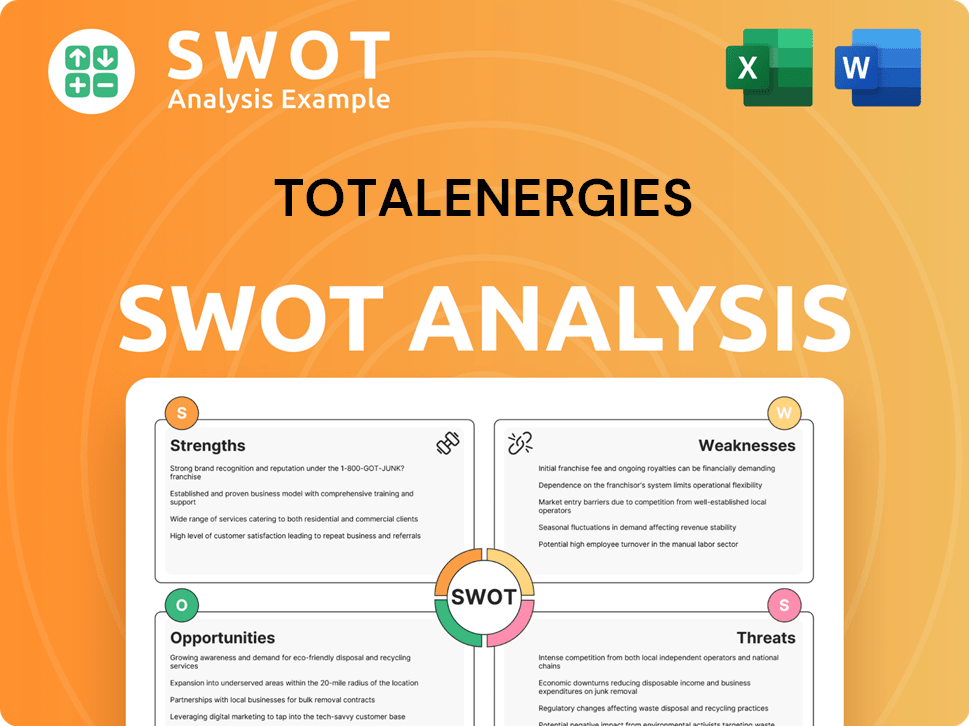
How Has TotalEnergies’s Ownership Changed Over Time?
The ownership structure of TotalEnergies, a prominent energy company, has evolved significantly since its inception. Initially nationalized in 1945, the company, then known as CFP, expanded its operations and integrated with other entities over the years. A key development was the merger with Compagnie Française de Raffinage (CFR) in 1974, which created a more unified energy enterprise. The period from 1990 to 1994 saw a notable increase in foreign ownership, reflecting the company's growing global presence.
Further transformations included the merger of CFP with Elf Aquitaine in 1991, leading to the formation of TotalFinaElf. This entity later rebranded to Total in 2003 and then to TotalEnergies in 2021. These changes reflect strategic shifts and the company's adaptation to the evolving energy landscape. The company's history is marked by strategic mergers and acquisitions that have shaped its ownership and operational scope, transforming it into a major player in the global energy market.
| Event | Year | Impact on Ownership |
|---|---|---|
| Initial Nationalization | 1945 | Government ownership established. |
| Merger with CFR | 1974 | Integration of refining and marketing operations. |
| Increased Foreign Ownership | 1990-1994 | Foreign ownership rose from 23% to 44%. |
| Merger with Elf Aquitaine | 1991 | Creation of TotalFinaElf. |
| Rebranding to Total | 2003 | Name change reflecting corporate strategy. |
| Rebranding to TotalEnergies | 2021 | Reflects a focus on energy transition. |
As a publicly traded company, TotalEnergies SE is listed on Euronext Paris, the NYSE (as an ADR), and the London Stock Exchange. As of June 1, 2025, institutional ownership accounted for 7.41% of the total shares outstanding, while insider ownership stood at 0.03%. Major institutional shareholders include Vanguard Total International Stock Index Fund Investor Shares and Goldman Sachs. Employee shareholding is also a significant aspect, as employees invested nearly 450 million euros in a capital increase reserved for them in 2025. To understand more about the company's strategic direction, you can explore the Growth Strategy of TotalEnergies.
TotalEnergies is a publicly traded company with a significant institutional and employee ownership. The company's market capitalization was $132.32 billion as of June 10, 2025.
- Institutional ownership: 7.41% as of June 1, 2025.
- Employee investment: Nearly 450 million euros in 2025.
- Mutual funds increased their holdings from 3.34% to 3.37% as of May 2025.
- Market Cap: $132.32 billion as of June 10, 2025.
TotalEnergies PESTLE Analysis
- Covers All 6 PESTLE Categories
- No Research Needed – Save Hours of Work
- Built by Experts, Trusted by Consultants
- Instant Download, Ready to Use
- 100% Editable, Fully Customizable
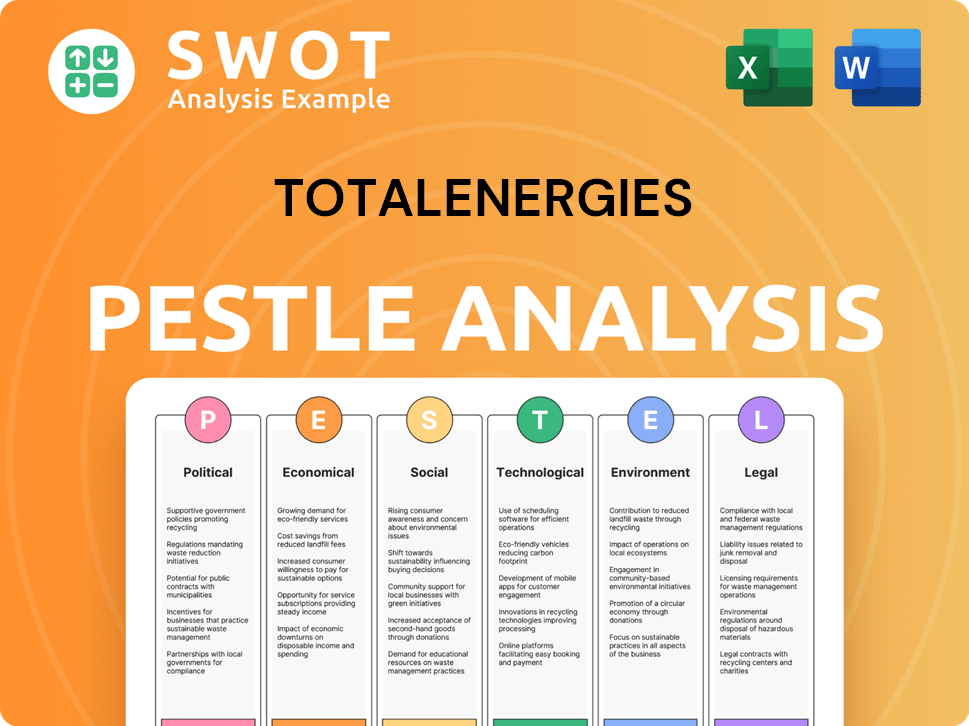
Who Sits on TotalEnergies’s Board?
The current governance of TotalEnergies, the TotalEnergies company, is overseen by a Board of Directors. The Chairman and CEO is Patrick Pouyanné. This structure, where one person holds both roles, has sparked debate among TotalEnergies shareholders, particularly regarding the balance of power and oversight within the company. In April 2024, a proposal to separate the Chairman and CEO positions was put forward, but the Board decided against including it in the May 2024 Annual General Meeting agenda, citing legal concerns and their commitment to the current governance model.
This decision led to legal challenges from groups like the Ethos Foundation, who viewed it as a restriction on shareholder democracy. The core of the debate focuses on how decisions are made and the influence of various stakeholders within the company. Understanding the dynamics of the Board and its decisions is crucial for anyone interested in the TotalEnergies ownership structure and its future direction.
| Key Governance Aspects | Details | Impact |
|---|---|---|
| Board Composition | Led by Chairman and CEO Patrick Pouyanné. | Influences strategic direction and decision-making. |
| Shareholder Proposals | A proposal to separate Chairman and CEO roles was rejected. | Highlights tensions over governance and shareholder influence. |
| Legal Challenges | Action taken by Ethos Foundation and co-filers. | Indicates ongoing scrutiny of governance practices. |
As of May 31, 2025, TotalEnergies SE had 2,270,057,201 shares in its share capital. While the total theoretical voting rights matched the number of shares, the exercisable voting rights were 2,202,109,248 after deducting 67,958,608 treasury shares. This difference is important because it reflects the actual voting power available to shareholders. Furthermore, the double voting rights granted to long-term shareholders, those holding shares for over two consecutive years, can significantly affect the distribution of control and decision-making within the company. This mechanism is a key aspect of understanding TotalEnergies ownership and how decisions are made.
Understanding the voting rights structure is key to assessing shareholder influence within TotalEnergies. This includes the impact of double voting rights for long-term shareholders.
- Double voting rights for long-term shareholders can shift the balance of power.
- The number of treasury shares impacts the total exercisable voting rights.
- Shareholder proposals and their outcomes highlight governance debates.
- The Board's decisions shape the company's strategic direction.
TotalEnergies Business Model Canvas
- Complete 9-Block Business Model Canvas
- Effortlessly Communicate Your Business Strategy
- Investor-Ready BMC Format
- 100% Editable and Customizable
- Clear and Structured Layout
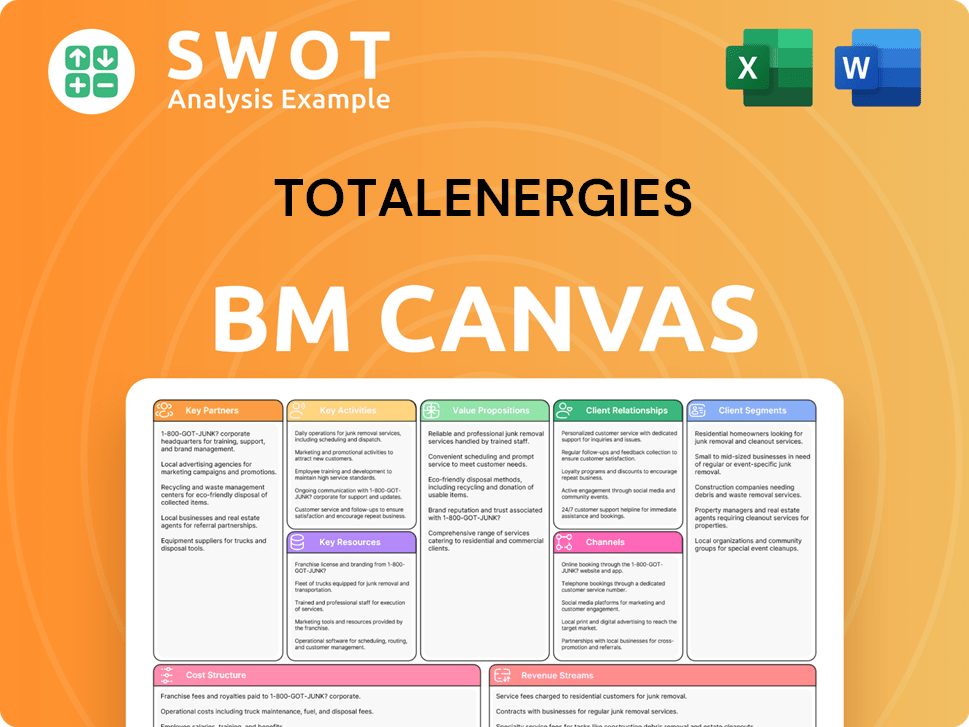
What Recent Changes Have Shaped TotalEnergies’s Ownership Landscape?
Over the past few years, TotalEnergies company has actively managed its ownership profile. In 2024, the company executed $8 billion in share buybacks, which represented 5% of its share capital. For 2025, share repurchases are projected to continue at a quarterly rate of $2 billion. As of March 31, 2025, the company repurchased 33.3 million shares for €2 billion. This demonstrates a commitment to strong shareholder returns, with a policy of allocating over 40% of cash flow from operations to investors.
In line with its energy transition strategy, TotalEnergies has also been active in mergers and acquisitions, particularly within the renewable energy sector. Acquisitions in 2024 and early 2025 included VSB Group, a European wind and solar developer, and SN Power, focused on hydropower in Africa, as well as renewables projects from RES in North America. These acquisitions are expected to contribute to TotalEnergies' target of 35 GW of gross renewable capacity by 2025 and over 100 TWh of electricity production by 2030. In December 2024, TotalEnergies acquired a 50% stake in Sapura Energy. The company also acquired three gas-fired power plants in Texas in 2023.
Regarding investment trends, TotalEnergies has invested in 48 companies over the last 13 years, averaging about two new investments annually in the last decade. In 2024, it made two investments, with its most recent first-time investment in ADNOC. While TotalEnergies previously had a corporate venture capital unit, TotalEnergies Ventures, it closed this $400 million arm and sold its portfolio of climate tech startups to venture capital firm Aster in 2023, shifting its focus to its early-stage accelerator program, TotalEnergies On. The institutional ownership of TotalEnergies SE was 7.47% in May 2025, with mutual funds increasing their holdings. This helps to understand who owns TotalEnergies and the dynamics of TotalEnergies ownership.
TotalEnergies executed $8 billion in share buybacks in 2024, representing 5% of its share capital.
Acquired VSB Group, SN Power, and renewables projects from RES to boost renewable capacity.
TotalEnergies invested in 48 companies over the last 13 years, with two investments in 2024.
Institutional ownership of TotalEnergies SE was 7.47% in May 2025, with increasing holdings by mutual funds.
TotalEnergies Porter's Five Forces Analysis
- Covers All 5 Competitive Forces in Detail
- Structured for Consultants, Students, and Founders
- 100% Editable in Microsoft Word & Excel
- Instant Digital Download – Use Immediately
- Compatible with Mac & PC – Fully Unlocked
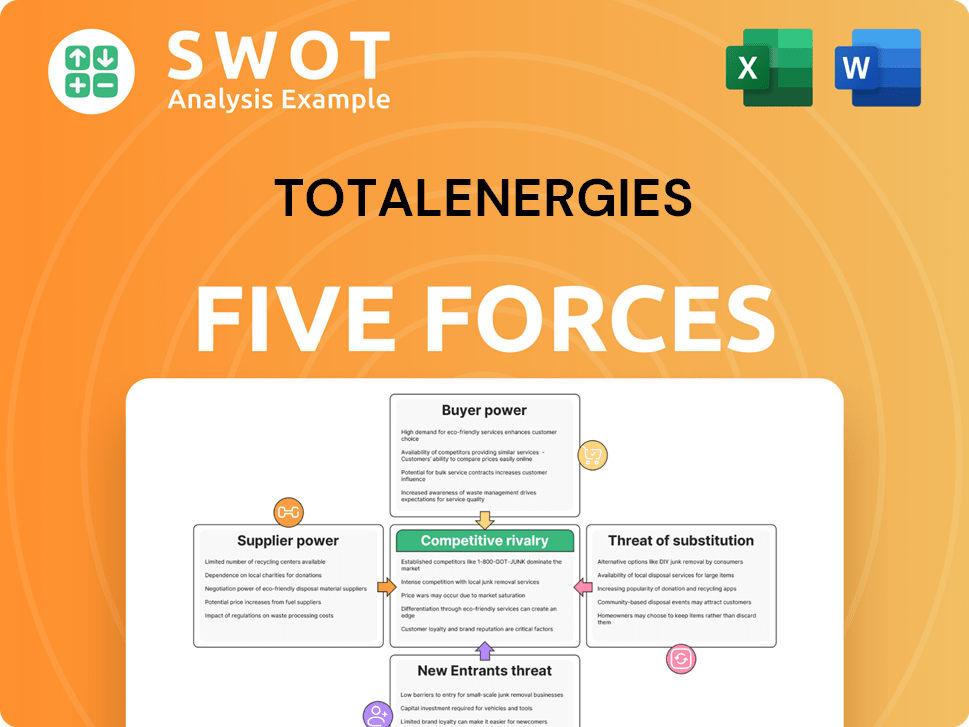
Related Blogs
- What are Mission Vision & Core Values of TotalEnergies Company?
- What is Competitive Landscape of TotalEnergies Company?
- What is Growth Strategy and Future Prospects of TotalEnergies Company?
- How Does TotalEnergies Company Work?
- What is Sales and Marketing Strategy of TotalEnergies Company?
- What is Brief History of TotalEnergies Company?
- What is Customer Demographics and Target Market of TotalEnergies Company?
Disclaimer
All information, articles, and product details provided on this website are for general informational and educational purposes only. We do not claim any ownership over, nor do we intend to infringe upon, any trademarks, copyrights, logos, brand names, or other intellectual property mentioned or depicted on this site. Such intellectual property remains the property of its respective owners, and any references here are made solely for identification or informational purposes, without implying any affiliation, endorsement, or partnership.
We make no representations or warranties, express or implied, regarding the accuracy, completeness, or suitability of any content or products presented. Nothing on this website should be construed as legal, tax, investment, financial, medical, or other professional advice. In addition, no part of this site—including articles or product references—constitutes a solicitation, recommendation, endorsement, advertisement, or offer to buy or sell any securities, franchises, or other financial instruments, particularly in jurisdictions where such activity would be unlawful.
All content is of a general nature and may not address the specific circumstances of any individual or entity. It is not a substitute for professional advice or services. Any actions you take based on the information provided here are strictly at your own risk. You accept full responsibility for any decisions or outcomes arising from your use of this website and agree to release us from any liability in connection with your use of, or reliance upon, the content or products found herein.